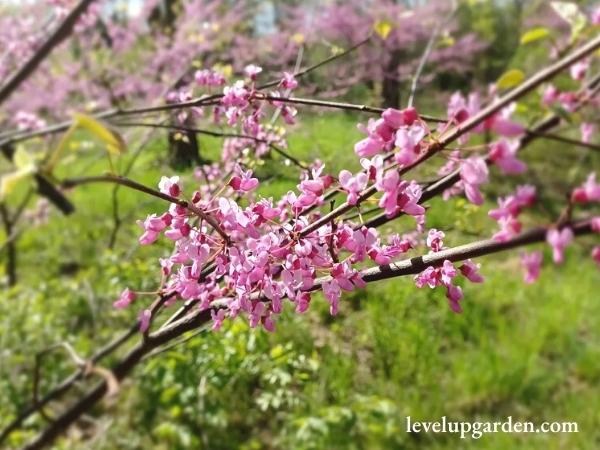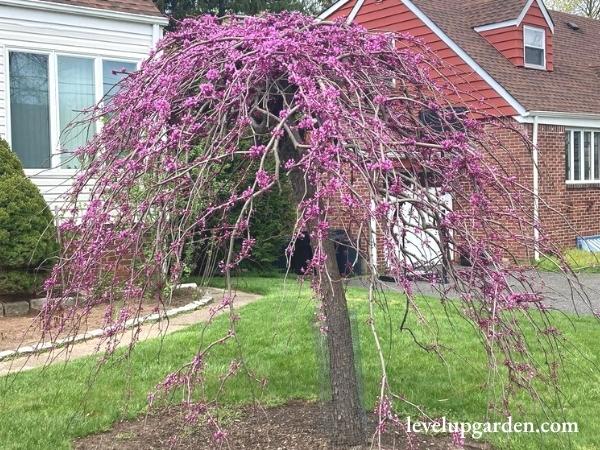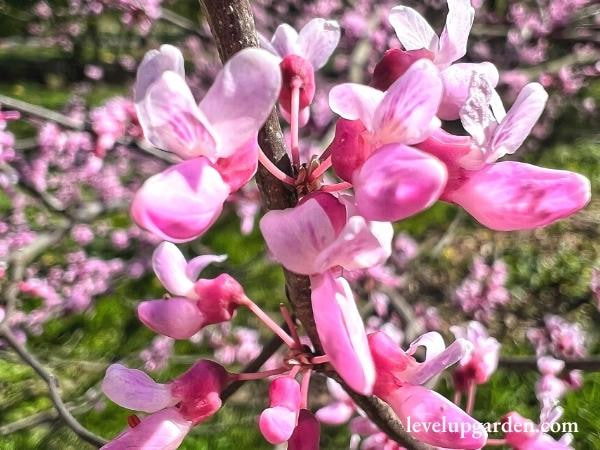Eastern Redbud (Cercis canadensis) is a small North American understory tree that flowers in early spring. It is native to the edges of forested areas with well-drained acidic soils. It is not very conspicuous except when flowering, and is a small tree that is often overlooked except in early spring. Before the leaves emerge, small bright pink flowers cover the stems and branches of the redwood, making it stand out like a beacon when driving on the highway.

It originated from southern Michigan to central Mexico and east to New Jersey. It is distributed as far west as California and as far north as southern Ontario, roughly equivalent to USDA cold hardiness zone 6b. It is also the state tree of Oklahoma.
If you’ve ever seen a tree with a trunk covered with pink flowers (but no leaves) in winter, you’ve probably encountered an Eastern Redbud bush. It is one of the first trees to bloom each year. However, due to disease, pest damage, and other environmental factors, the life span of this tree species is short (averaging less than 20 years). However, many feel that its beauty makes it worth planting.
Its scientific name is Cercis canadensis, and it belongs to the Fabaceae family, the same family that includes Kentucky coffee, wattle (Acacia sp.), powder puff tree (Albizia sp.), and wisteria (Wisteria sinensis). Eastern Redbud is the common name for the genus. Some species use this name, although it is also known simply as “redbud”. Others call it Judas tree, but the name Cercis siliquastrum is more appropriate.
It reaches 20 to 30 feet tall and 25 to 35 feet wide. It forms in an urn shape and tends to grow multiple trunks. Eastern Redbud has leaves that are heart-shaped and are about 3 to 5 inches across. They are green for most of the growing season, fading to yellow-green in the fall.
Moreover, bean-like flowers appear in late winter and early spring before the leaf buds swell. Most red-veined ferns have pink flowers, but some varieties have white flowers. The fruits are similar to those of closely related species. The flowers produce green pods filled with black seeds and after summer, the pods turn brown and dry out.
I. Eastern Redbud Profile – An Overview of the plant

| Common Name | Eastern redbud, American redbud, American Judas tree |
| Botanical Name | Cercis canadensis |
| Family | Fabaceae |
| Genus | Cercis |
| Species | C. canadensis |
| Plant type | Tree |
| Height | 20 to 30 feet |
| Spread | 25 to 35 feet |
| Sun | Full sun, part shade |
| Soil Type | Well-drained |
| Soil pH | Neutral to slightly alkaline (6.6 to 7.8) |
| Bloom Time | Spring |
| Flower Color | Pink |
| Zones | 4 to 8 (USDA) |
| Native Area | North America |
| Mature Height | 20-30 ft. |
| Mature Width | 10-15 ft. |
| Growth Rate | Moderate |
| Native Range | Eastern North America |
| Water | Medium |
| Maintenance | Low |
II. Appearance
Eastern Redbud typically grows 6-9 m tall and 8-10 m wide. The trunk is generally short, often twisted, with spreading branches. Ten-year-old trees are generally about 5 m tall.

The bark is dark, smooth, and later scaly, with somewhat conspicuous ridges and sometimes brown spots. Twigs are slender and zigzag, almost black with bright lentiginous spots. Winter buds are small, rounded, and dark red to chestnut.
In spring and early summer, clusters of showy, pale pink to dark magenta flowers bloom on bare stems, sometimes on the trunk itself, prior to the foliage. Some varieties have white flowers. The flowers are pollinated by long-tongued bees such as the blueberry bee and the carpenter bee.
However, bees with short tongues cannot reach the nectar source. Fruits are flattened, dry, brown bean-like pods 5-10 cm long, containing flattened, oval, brown seeds 6 mm long, maturing from August to October.
Eastern Redbuds leaves are 2-5″ long, 5-7-nerved, cordate or lobed at base, sharply pointed throughout, alternate, simple, heart-shaped or broadly ovate. From buds to folded along midrib, yellow-green, smooth as it grows, dark green above, paler below. In autumn it turns bright clear yellow. Petiole slender, pointed at the tip and enlarged at the base.
The flowers are followed by flat, pea-like pods, but many trees are sterile and do not bear fruit. These pods start out green but eventually turn to brown as they mature in mid to late summer. The 2 to 4 inch long pods contain 4 to 12 flat, oval, brown to black, kidney-shaped seeds.
Fabaceae, slightly spiny, unequal, rectangular, pointed at both ends. Compressed, with a remnant of style at the tip, straight at the top and curved at the bottom. 2.5 to 3 inches long, rose-colored, growing in midsummer and dropping in early winter. Seeds 10 to 12, chestnut color, 1.5 cm long.
III. Growing and Care Conditions
Eastern Redbud can grow successfully in zones 4 to 8. Originating from the Midwestern and Eastern US. After a proper establishment period of one to two years, it is considered to be a drought tolerant tree. It is one of those plants that does not like to be transplanted, so choose your site carefully and do not move it.

Eastern Redbud attracts hummingbirds and butterflies. If you have black walnut trees on your property, you can plant them nearby. Eastern Redbud can tolerate the allelopathic nature of black walnut and juglone toxins.
Planting
Easily grown in average medium moisture, well-drained soil in sun to shade. Shade is best during hot summer months. Soils of moderate fertility and constant moisture are best. Avoid moist or poorly drained soils. This tree does not transplant well and should be planted young and left alone.
Choose a sunny location (afternoon shade) with well-drained soil and 4 to 6 hours of direct sunlight and make sure that it is a location that does not have strong winds to prevent breakage. Dig a hole twice as wide as the diameter and as deep as the tree’s roots. Place the tree, backfill with soil, and water to allow the tree roots to settle. Finally, spread 3 to 4 inches of mulch over the planting area to maintain humidity.
Light
Eastern Redbud grows well in sun to shade. The more sun it receives, the more flowers it will produce. But, in hotter regions, shade is recommended.
Watering
Water the plant once or twice a week for the first year. If you are not sure when to water, check the surrounding soil down about 3 inches. If the soil is dry, it is time to water.
After the first year, Eastern Redbuds can thrive on rainfall alone. But, it is recommended that you continue to check the soil. The soil should remain moist about 3 inches down.
Fertilizer
Apply a complete fertilizer such as compost or 5-10-5 in early spring. Apply evenly around the base of the plant according to label instructions. The tree, like many Fabaceae species, can utilize nitrogen from the air through a process called nitrogen fixation. Fertilizer will not be needed unless symptoms or tests show abnormalities.
Soil Requirements
The tree can tolerate any soil type, sandy or clay soils with a wide range of pH values. The soil must always be moist and does not need to be excessively fertile. The most optimal is medium fertile soil. Most importantly, it must be well drained.
Pruning
Pruning should be done in early summer after flowering has ended. First, remove large lower branches, crossed branches, and branches that are rubbing against each other.
Branches close to the trunk should be cut off so as not to leave the base. If several branches are needed to be removed, do so gradually over several months. At the end of winter, prune dead or damaged trees and remove shoots growing from the bottom of the trunk.
Pests and Diseases
Pests and diseases can be one of the most common problems for Eastern Redbud trees. One of the most common diseases afflicting the plant is leaf anthracnose. Cankers, which cause lesions on the stems and twigs of Himalayan cedar trees, are also a common problem. In extreme cases, these diseases can kill the tree.
Cankerworms can be a serious disease problem.Other diseases like verticillium wilt, dieback, leaf spot, mildew, and blight can also occur. Insect pests include beetles, treehoppers, leafhoppers, caterpillars, borers, and caddis beetles. Regular watering, fertilization, and pruning of dead branches as needed to maintain vigor will help keep the tree healthy. Deer tend to avoid this plant.
Varieties
There are varieties of Eastern Redbud, one of them is “Alba”. It is smaller than the original species, reaching only about 15-25 feet tall. Another one is called “Ace of Hearts”, a compact 12-foot-tall variety with bright pink flowers.
There are other varieties like “Forest Pansy Rose Purple” that bloom relatively late. There is also “Pink Pompon”, which has dark pink double flowers with glossy foliage. Finally, “Covey”, five to six feet tall and six to eight feet wide, has leaves that turn yellow in fall.
IV. Uses
Eastern Redbud has flowers and young legumes that are edible. The extracts from the inner bark and roots were used to treat colds, flu, and fevers. Also, branches and stems were used to make baskets.

Native Americans ate Eastern Redbud flowers raw or cooked, and the young pods were also eaten raw or cooked. The flowers can also be made into pickles. They are slightly sour and rich in vitamin C, and they can be added to salads or used as a condiment.
The unopened buds can be pickled or used as a substitute for capers. The seeds are composed of about 25% protein, 8% fat, and 3% ash. It can be seen that it is a very nutritious ingredient.
In some parts of southern Appalachia, green sprigs of Eastern Redbud are used as a seasoning for venison, opossum, and other wildlife. For this reason, in this mountainous region, Eastern Redbud is sometimes referred to as the spicewood tree.
Native Americans knew the tree well and had many uses for it. The flowers are 25% protein, contain significant amounts of vitamin C, and are full of antioxidants. They used the roots and bark in herbal pharmacies and, like the willow tree, brewed cough and fever teas from those parts.
The thin branches were also used to make baskets, and saplings were sometimes cut close to the ground to produce multiple shoots. The flowers are not only edible, but also produce a beautiful yellow natural dye. Yes, a yellow dye can be produced from pink flowers.
The pea-like pods, leaves, and mature seeds are also edible. The flowers and pods resemble peas because they are related to the legume family, which includes beans and peas. However, the red-eyed pea does not fix nitrogen in the soil like leguminous plants.
V. Why should you buy this plant
Eastern Redbud is prized for its bright purplish-pink flowers that bloom in the warmer months, heralding the transition from winter to spring. In fact, it is one of the first trees to bloom each year, and because it blooms on older trees. It provides a breath of fresh air after the cold season.

But despite its delicate appearance, Eastern Redbud is surprisingly strong. It can grow as far west as California, parts of Florida, and even north. It can tolerate temperatures down to minus 20 degrees and can easily withstand ice damage. In addition, it can adapt to most soils.
The rounded, dense canopy, unique branching, and changing foliage colors throughout the seasons. You can get this plant without any care or guesswork. Eastern Redbud is a great addition to any garden. Whether you want to add color to your home garden or accent your patio, you can’t go wrong with this tree.
The Eastern Redbud produces delicate, rosy pink flowers. If you are looking for an eye-catching color along your garden or fence, this tree is a great choice. The Eastern Redbud unique branching also complements the trunk, which branches close to the ground, creating a striking silhouette in the landscape.
It is one of the first trees to bloom, with beautiful pink buds in early spring. As the seasons change, the tree shows off more of its iconic colors. After the last flower finishes blooming, the Eastern Redbud’s foliage shows a variety of colors, ranging from magenta to yellow.
This tree is also a great choice for the winter garden. Not only is it drought tolerant, but its deep roots allow it to withstand storms, wind, and ice damage. As it matures, the bark turns black, making it ideal for snowy landscapes. In good health, this tree has been known to live up to 75 years while maintaining a compact ornamental appearance, if you are looking for long-lasting color, this is the tree for you.
Even better, the Eastern Redbud fits into even the smallest landscapes. No matter the space in your yard, you can enjoy the Eastern Redbud’s full blooms, vibrant foliage, and unique expansive silhouette. Nothing can detract from the spectacular color of Eastern Redbuds throughout the spring, summer, and fall seasons.
VI. FAQs
What is the lifespan of a Eastern Redbud tree?
In good health, it has a lifespan of 50 to 70 years. However, certain pathogens, especially Verticillium wilt, a fungal wilt, and trunk cancer can significantly shorten its lifespan.
Can you prune Cercis canadensis?
Pruning is best done in the spring after flowering has ended. Alternatively, it can be pruned in late winter, during dormancy before flowering, but this will remove some of the flowers.